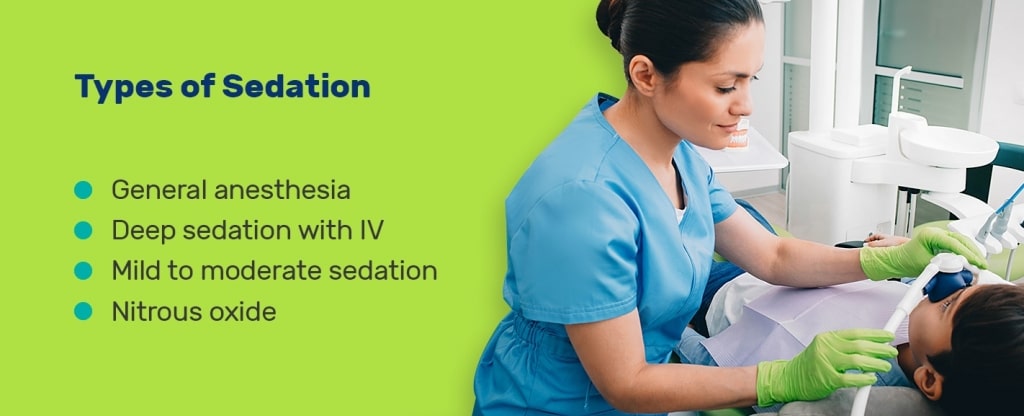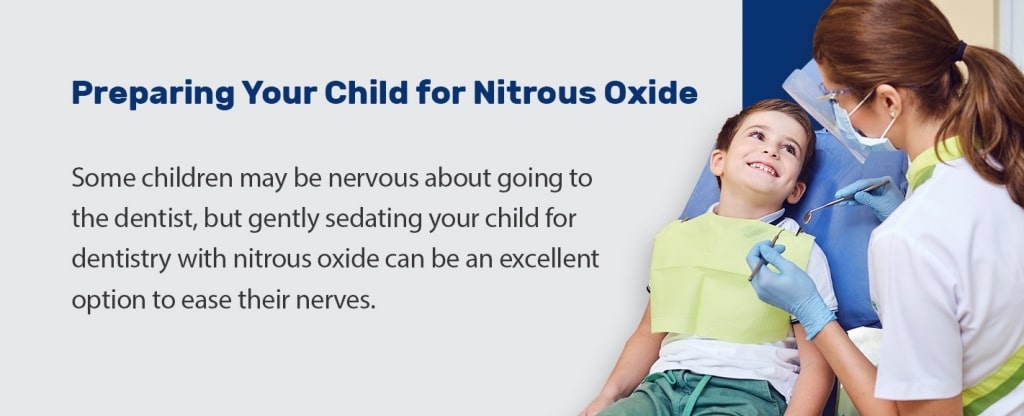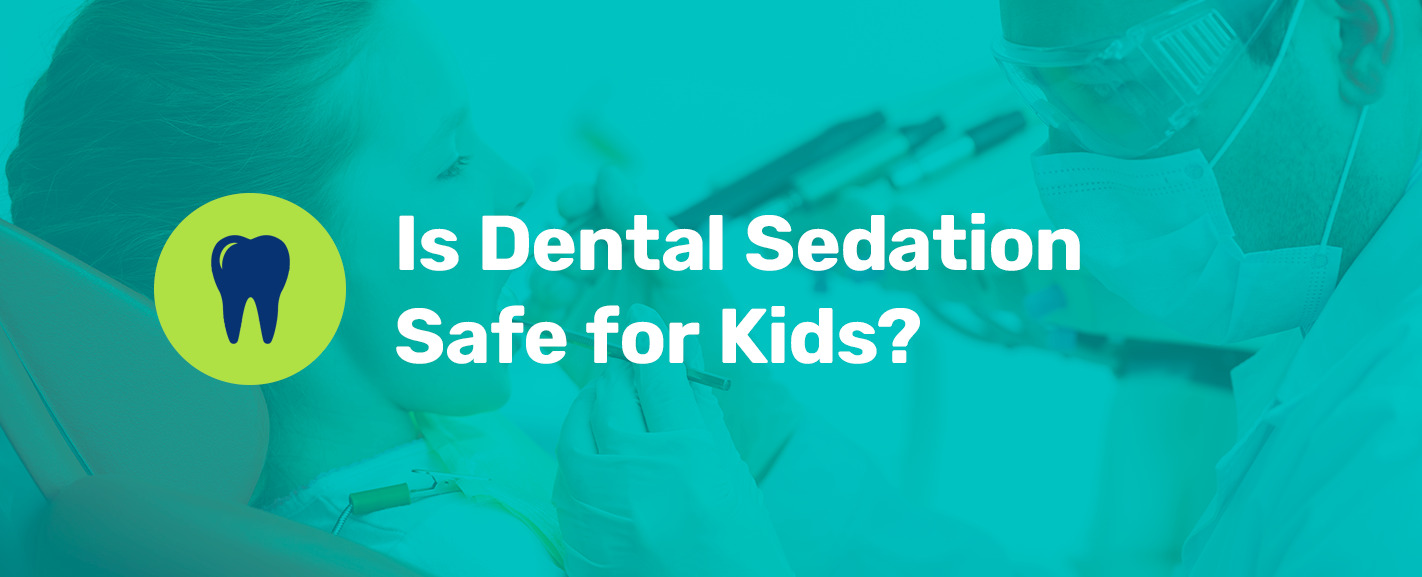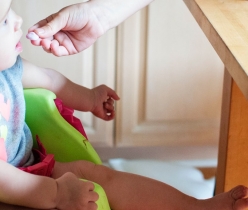Visiting the dentist can trigger anxiety or stress in children, and when they know they need an unfamiliar procedure, they dread the experience enough to panic when they arrive. To help child patients cope with their anxieties, dental offices provide sedation services to make the procedures comfortable and to assist patients with compliance.
One of the most reliable and safe sedation methods available is nitrous oxide, which is commonly used in pediatric dentistry. This practical option helps children relax and comes with few side effects. Are other forms of sedation dentistry safe for toddlers and children? Read on to find out more about your options.
Types of Sedation

Pediatric dental professionals use several types of sedation:
- General anesthesia: An anesthesiologist safely administers this type of sedation so the dentist can focus on performing the procedure. The effect of general anesthesia is that the child will sleep peacefully, unable to disrupt the operation or feel any pain. Intubation is necessary for this type of sedation, and the child also requires an intravenous (IV) to have it administered.
- Deep sedation with IV: IV medications help a child sleep through the procedure. An anesthesiologist or other trained professional must be present to monitor vitals while the dentist works. The child will be asleep, but still may be able to move around a little or make noises. A breathing tube is usually used with deep IV sedation.
- Mild to moderate sedation: The dentist may use oral medications to help a child relax, or make them a little sleepy. The child generally remains awake, or wakes easily if they do fall asleep. With this type of sedation, the child is responsive and able to move and respond. Usually, an anesthesiologist does not need to be present, as the dentist can administer these medications. IVs and breathing tubes are not used with mild and moderate oral sedation.
- Nitrous oxide: This gas is mixed with oxygen for the child’s safety and acts as a mild sedative. Nitrous oxide produces a relaxing effect without causing the child to fall asleep. While under the influence of the gas, they might feel lightheaded or experience a strange sensation like they are floating. Another name for nitrous oxide is “laughing gas” because of the elevated mood it can cause. It is also one of the least invasive sedation methods that dentists use. Nitrous oxide can be titrated easily to adjust the amount of gas that the patient needs. Because it wears off so quickly, its residual effects are low.
Your dentist can discuss these options with you and review the details of the procedure, along with your child’s health history, so you can make informed choices together regarding pediatric dental sedation safety for your children.
Side Effects of Nitrous Oxide in Children’s Dentistry
Nitrous oxide is considered one of the safest kinds of sedation, although all types are very safe. However, side effects are still a possibility.
- Short-term side effects: Uncommonly, side effects may occur after too much nitrous oxide is inhaled or when the gas frequently fluctuates during the procedure. Inhaling an excess of gas in children can cause fatigue, nausea, vomiting, shivering, sweating and dizziness. Generally, these side effects are mild and quickly stop minutes after the gas is turned off.
- Long-term side effects: Long-term side effects of nitrous oxide are very rare. However, please contact your dentist’s office if you notice any potential unusual side effects that could be related to the sedation.
- Side effects in toddlers and children: The short-term side effects are very similar for children and may include nausea and vomiting.
Adult and child patients can benefit greatly from sedation. The risks of going without sedation are usually too high for most patients undergoing certain procedures. Most sedation side effects are mild and reversible. With nitrous oxide, side effects fade shortly after the gas is turned off. Long-term effects are nearly always caused by misuse of equipment due to negligence, which is why it’s important to go to a practice with certified dentists who take patient safety seriously.
Preparing Your Child for Nitrous Oxide

Many children get nervous when they need to go see the dentist or any other doctor, but nitrous oxide sedation helps ease nerves, resulting in compliant patients and an easy procedure free of fear. If your dentist’s office decides that nitrous oxide sedation is the most appropriate choice for your child’s dental procedure, your dentist or hygienist will provide a breathing mask so that they can inhale the combination of oxygen and nitrous oxide gas.
The dentist administers sedation a minute or two before starting the procedure and continues to administer more gas until the treatment is finished. As they work, dental professionals must conduct precautionary vital sign checks to ensure the child remains stable. Although safety checks might be inessential for the usage of nitrous oxide in the majority of cases, they are standard preventative measures that guard your child.
While deep sedation puts the patient into a deep sleep and might require equipment to assist with breathing, light sedation methods allow the patient to respond to commands while having limited awareness. When the doctor turns off the gas, the fresh air clears any residual nitrous oxide from the lungs fairly quickly.
While your child receives the nitrous oxide, you can be in the same room, and you can often be present for the entire procedure, so if needed, you can reassure them. Discussing the appointment with your child may be helpful for setting aside any fears or doubts. Speak with honesty and use clear, careful language to explain what will happen when they undergo the procedure and encourage them not to be afraid. Your child may feel better after talking with you about the steps and why the procedure is needed.
Fasting before the procedure is not necessary for nitrous oxide sedation as it is with other types of sedation. A light meal beforehand is allowed. No other specific preparation at home is necessary.
How Long Does It Take for Oral Sedation to Wear Off?
How long it takes for a type of sedation to wear off will depend on a few factors. The effects of nitrous oxide tend to lift quickly, taking only about five minutes to subside. IV sedation and oral medications can take several hours, and after your child starts to feel like themselves again, traces of these medications will remain in their system.
After you have taken your child home, it’s a good idea to stay with them or have another adult watch them until the medication’s effects have subsided. Even with light sedation, the child requires time to recover before they will feel 100% better. The effects could linger after a brief stay in a recovery room, which might not be required for children getting nitrous oxide. It’s important that your child spends the rest of the day at home instead of going back to school or engaging in sports and other activities.
If you would like more detailed information about sedation methods, your child’s doctor can provide you with all the necessary information for the patient’s recovery following the particular procedure.
Aftercare for Dental Sedation
After sedation, your child may be groggy, confused, emotional or nauseous. These reactions to anesthesia are normal and will gradually wear off. When you take your child home, make sure you do the following:
- Help your child eat and drink for 2 hours after the procedure. They will have numbness in their mouth and maybe their nose and throat. Make sure they are careful not to accidentally bite down on their tongue or the inside of their cheeks.
- Feed your child soft foods after the dental procedure, gradually introducing firmer food that they can chew.
- Encourage your child to drink water.
- Keep your child out of school or daycare for the rest of the day.
- If you notice swelling, give your child an ice pack to hold over their jaw.
- If your child has been prescribed pain medication to take after the procedure, help them take their first dose.
- Make sure you have discussed scheduling a follow-up appointment with your doctor.
To provide the best quality of aftercare, discuss the sedation method that your doctor or dentist plans to use, and follow all directions. Some types of light sedation might require a visit to a recovery room before the child is able to go home. Nitrous oxide wears off so quickly that the child can usually go home right away.
When Is Sedation Used in Dentistry?
For patients who are uncomfortable undergoing dental procedures, sedation dentistry can make the experience more bearable or in some cases, safer. Children with severe anxiety and panic about having to visit the dentist benefit from light sedation during simple procedures such as tooth cleanings. Other children might only require sedation during invasive procedures.
For simple procedures, sedation is optional, and your choice as a caretaker plays a role in the decision. Your dentist might recommend sedation for a certain child and allow you to make the final call.
Is Dental Sedation Safe for My Child?
The bottom line is that dental sedation, especially nitrous oxide, offers a high degree of safety for all patients, including children. Most dentists offer nitrous oxide when performing procedures where light sedation can make patients feel comfortable and relaxed. Deep sedation is required for dental procedures in some instances, but nitrous oxide is a commonly employed methods of putting children in a calm state during a procedure. This makes dental work less stressful for some, while others would be unable to undergo the procedure at all if they were fully aware.
As each child is different, your dentist will want to review your child’s health history and any other concerns before the procedure. And although dental sedation is very safe, many considerations go into choosing the options for each treatment. Consult with your pediatric dentist to determine the ideal choices for your child.
Other forms of sedation– oral conscious sedation, IV sedation, or general anesthesia have a higher risk of complication and side effects compared to sedation with laughing gas alone. It is important for any parent to make sure they report a true and honest health history to your child’s dentist, as certain patients may not be good candidates for the above-listed types of sedation. Additionally, your child’s dentist needs to be properly trained and certified to provide nitrous oxide or sedation. Each state requires that dentists hold a special certificate or permit enabling them to perform sedation procedures.
For the best pediatric dentistry in Portland, come to Sprout Pediatric Dentistry & Orthodontics. We specialize in children’s dentistry and orthodontics to help guide your child through all stages of their oral health journey. Contact us for an appointment today to get started. We pride ourselves not only on our knowledge of children’s needs but also on our friendly, approachable staff. We have a variety of treatment options and work with you to determine the safest and most comfortable dental procedures for your child.

Dr. Dana grew up in Portland and went to Temple University in Philadelphia, PA for dental school. She then moved to Anchorage, AK for her residency in Pediatric Dentistry. Dr. Dana takes a holistic approach to pediatric dentistry & is able to use her own parenting experience to sympathize and understand each family’s unique dynamic.



